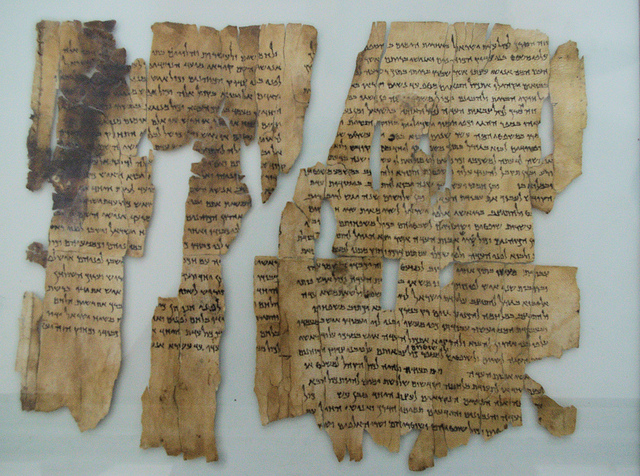By: Sherene Khouri, Ph.D. | April 23, 2023
This is an answer to our readers’ questions: What are the Dead Sea Scrolls? Who were the Qumran community? Who were the Essenes?
What are the Dead Sea Scrolls?
The Dead Sea Scrolls are one of the most ancient scrolls that historians have ever known. They were discovered in late 1946 or early 1947 by Bedouin shepherds in a cave near an area called Qumran in Jordan, which is about one mile away from the western shore of the Dead Sea and thirteen miles east of Jerusalem. One of the shepherds went astray and the shepherds went searching for it. According to their account, one of the shepherds “threw a stone into a small circular opening in the cliff face. Instead of the expected smack of rock against rock, he heard a shattering sound.”[1] They were scared at the beginning, but when they returned to the cave, they “found decaying rolls of leather in one of a number of strange elongated jars embedded in the floor of the cave.”[2] These were the first discovered Dead Sea Scrolls and the cave was named Cave 1 because several other caves (about eleven of them) were excavated after that incident.
Excavated Scrolls
There are 1,250 Dead Sea Scrolls excavated, of which 1,050 were found at Qumran.[3] According to Flint, “More scrolls were discovered at other locations in the vicinity of the Dead Sea, especially at Wadi Murabba‘at (about 120 scrolls in 1951– 1952), Nahal Hever (over 70 scrolls in 1951- 1961), and Masada (15 scrolls in 1963– 1965).”[4] However, the term Dead Sea Scrolls refers to all the scrolls that were discovered in the area, including at the Qumran site.
The discovery includes almost 300 biblical scrolls (about 29% of all the discovered scrolls), of the Apocrypha and Pseudepigraph about 150 scrolls, and of the nonbiblical scrolls about 600 scrolls.[5] The language used in these scrolls was Hebrew, Aramaic, and Greek. It comprises the earliest witness to the Old Testament. Scholars date these scrolls between 250 BC to AD 68. The biblical books that were discovered include all the Old Testament books except for the book of Esther. These scrolls were written too early to contain any of the New Testament writings.
In 1947, Cave 1 was discovered. The scrolls were put in jars and many other things were excavated or discovered in this cave, such as covers, bowls, a pot, a pitcher, four lamps, three phylactery cases, a wooden comb, and about 50 linens.[6] Between 1952 and 1956, ten more caves were discovered in the vicinity. None contained extensive manuscripts.
About the Author
Sherene Khouri was born into a religiously diverse family in Damascus, Syria. She became a believer when she was 11 years old. Sherene and her husband were missionaries in Saudi Arabia. Their house was open for meetings, and they were involved with the locals until the government knew about their ministry and gave them three days’ notice to leave the country. In 2006, they went back to Syria and started serving the Lord with RZIM International ministry. They traveled around the Middle Eastern region—Turkey, Jordan, Egypt, Lebanon, Syria, and United Arab Emirates. Sherene was also involved in her local church among the youth, young adults, and women’s ministry. In 2013, the civil war broke out in Syria. Sherene and her husband’s car was vandalized 3 times and they had to immigrate to the United States of America. In 2019, Sherene became an American citizen.
Sherene is an assistant professor at Liberty University. She teaches Arabic, Religion, and Research classes. Sherene holds a Ph.D. in Theology and Apologetics, M.A. in Christian Apologetics from Liberty University, and B.S. in Biblical Studies from Moody Bible Institute. She is also working on a Master of Theology in Global Studies at Liberty University and a M.A in Arabic and Linguistics from PennWest University.
Copyright 2023. Bellator Christi.
Notes
[1] Brent Nongbri, “How the ‘Jerusalem Scrolls’ Became the Dead Sea Scrolls from Qumran Cave 1: Archaeology, the Antiquities Market, and the Spaces In Between,” Harvard Theological Review 115, no. 1 (2022): Gale In Context: Biography (accessed April 20, 2023). https://link.gale.com/apps/doc/A698014888/BIC?u=vic_liberty&sid=summon&xid=91cad94e.
[2] Ibid.
[3] Peter W. Flint, The Dead Sea Scrolls (Nashville: Abingdon Press, 2013), 23.
[4] Ibid.
[5] Ibid., 79.
[6] Ibid., 37.





